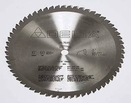How to Remove Pitch From Woodworking Saw Blades
Disclaimer: Because woodworking blades and the solvents used to clean them can be extremely dangerous, please exercise the utmost care and caution at all times when working with or near these items.
 To begin, I suppose I should first say a little bit about this mangy little thing called pitch. To put it as simply as possible, pitch is that sticky build-up or, literally, tree sap and other natural materials that accrue on your blades with each pass through a piece of wood. These materials cling to the entire blade and essentially suffocate its effectiveness. Under a veil of pitch, your blades retain heat, they can lose temper, and even warp and will without a doubt quickly become dull and sloppy – your blade’s will overall performance will suffer. Pitch is also known to contribute to blade binding and kickback.
To begin, I suppose I should first say a little bit about this mangy little thing called pitch. To put it as simply as possible, pitch is that sticky build-up or, literally, tree sap and other natural materials that accrue on your blades with each pass through a piece of wood. These materials cling to the entire blade and essentially suffocate its effectiveness. Under a veil of pitch, your blades retain heat, they can lose temper, and even warp and will without a doubt quickly become dull and sloppy – your blade’s will overall performance will suffer. Pitch is also known to contribute to blade binding and kickback.
Needless to say, it is important to keep your saw blades clean and free of this bloody pitch to ensure the best cutting results and most optimal longevity from your saw blades.
Of course there are plenty of pitch and blade specific cleaning solutions available at your finer woodworking shops, but you might just have something around the house that will do the job just as well; oven-cleaner
. Oven-cleaner is perfectly non-abrasive and, as advertized, designed to break-up and remove tough, stuck, baked-on gunk – essentially, pitch. Because pitch does literally bake onto your blades during the friction of use, oven-cleaner is as effective as the werewolf’s silver bullet. Another simple household cleaner that strangely seems to have been designed for cleaning blades is, well, toilet bowl cleaner. It’s tough on pitch, it’s my preferred blade-cleaning method, and it leaves your blades sparkling like polished porcelain.
After soaking your blade for an hour (or a few depending on the degree of pitch build-up) simply wipe or scrub any problem areas (paying special attention to the teeth and the gullets between them) with a non-abrasive pad, then rinse and dry thoroughly. Never use an abrasive scrubbing tool (i.e. steel-wool, a metal scraper, etc) or anything else that could scratch the surface of your blade. Surface grooves will effect both the blade’s performance as well as your ability to clean the pitch from them later. If there are scratches in your blades, those grooves will fill up with that sticky pitch you are trying to remove. Of course its possible to get it out, it’s just a much greater hassle and presents the serious danger of using compromised blades which are essentially a ticking time-bomb when spinning on your saw. If any scrubbing is necessary, use only softer scrubbing or scraping tools (i.e. plastic, nylon, brass bristled brushes, etc). I repeat, do not risk the integrity of your blade with abrasive scrubbing or scraping tools. Additionally, if your blade has a friction reducing coating (applied by manufacturer) use a scrubbing utensil designed or safe for Teflon kitchen-ware. This will ensure the coating remains intact and effective.
Repeat soaking and gentle scrubbing process until the blade is clean. Thoroughly rinse the blade with water and dry thoroughly with a clean, soft, lint-free cloth. Drying your blades will help keep them rust free. Before reinstalling your perfectly clean blade, apply a thin coat of WD-40 to keep that sucker cleaner for a longer period of time. This will also ensure the blade spinning and slicing as smoothly as possible.
Please Note: Although oven-cleaners are a very effective household remedy, they are, of course, risky methods as well. Some oven-cleaners have corrosive elements which overtime can damage the integrity of your blades. Ensure you use a product (whether oven-cleaner or not) without corrosive elements before subjecting your blades to the soaking process and yourself to the threat of a compromised blade.
Soaking your blades overnight in mineral spirits or kerosene are other non-abrasive, non-corrosive, effective pitch removal methods. Using the same soaking, gentle scrubbing, rinsing and drying process as above, these should get your blades clean and shining like brand-new. Keep in mind, however, when using these methods that these solutions are highly flammable. Be cautious and always utilize safe practices when working with blades, high-heat, or open flame. Be aware also of the dangers of using kerosene – use as little as possible and be sure to store and dispose of it properly. Additionally, before using any solution to clean your blades, either from under the kitchen sink or over the woodshop counter, thoroughly read the directions and safety/warning labels. Also remember to soak your blades in a safe and well-ventilated area away from pets, children, or any other living or non-living thing that can hurt or be hurt by your arrangements. Additionally, after being used as your “blade-soaking container”, blade-soaking containers should not be used for any other purpose. Clean them and either properly dispose of them or store them for future blade-soaking.
And after all that, your blades should be perfectly clean and in tippy-top, super-fighting condition. Remember to clean them regularly for the best cutting results and optimal blade longevity.













